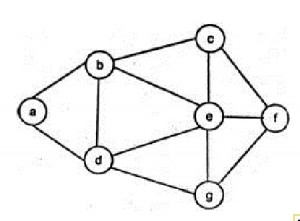Gate IT 2008
Question 41
The following three are known to be the preorder, inorder and postorder sequences of a binary tree. But it is not known which is which.
MBCAFHPYK
KAMCBYPFH
MABCKYFPH
Pick the true statement from the following.
MBCAFHPYK
KAMCBYPFH
MABCKYFPH
Pick the true statement from the following.
Question 42
Question 43
Consider a hash table of size 11 that uses open addressing with linear probing. Let h(k) = k mod 11 be the hash function used. A sequence of records with keys
43 36 92 87 11 4 71 13 14
is inserted into an initially empty hash table, the bins of which are indexed from zero to ten. What is the index of the bin into which the last record is inserted?
43 36 92 87 11 4 71 13 14
is inserted into an initially empty hash table, the bins of which are indexed from zero to ten. What is the index of the bin into which the last record is inserted?
Question 44
What is the output printed by the following C code?
C
# include <stdio.h>
int main ()
{
char a [6] = \"world\";
int i, j;
for (i = 0, j = 5; i < j; a [i++] = a [j--]);
printf (\"%s\\n\", a);
}
/* Add code here. Remove these lines if not writing code */
Question 45
Consider the C program below. What does it print?
C
# include <stdio.h>
# define swapl (a, b) tmp = a; a = b; b = tmp
void swap2 ( int a, int b)
{
int tmp;
tmp = a; a = b; b = tmp;
}
void swap3 (int*a, int*b)
{
int tmp;
tmp = *a; *a = *b; *b = tmp;
}
int main ()
{
int num1 = 5, num2 = 4, tmp;
if (num1 < num2) {swap1 (num1, num2);}
if (num1 < num2) {swap2 (num1 + 1, num2);}
if (num1 >= num2) {swap3 (&num1, &num2);}
printf (\"%d, %d\", num1, num2);
}
/* Add code here. Remove these lines if not writing code */
Question 46
Consider the C program given below. What does it print?
C
#include <stdio.h>
int main ()
{
int i, j;
int a [8] = {1, 2, 3, 4, 5, 6, 7, 8};
for(i = 0; i < 3; i++) {
a[i] = a[i] + 1;
i++;
}
i--;
for (j = 7; j > 4; j--) {
int i = j/2;
a[i] = a[i] - 1;
}
printf (\"%d, %d\", i, a[i]);
}
/* Add code here. Remove these lines if not writing code */
Question 47
C program is given below:
C
What should be the contents of the array b at the end of the program?
# include <stdio.h>
int main ()
{
int i, j;
char a [2] [3] = {{\'a\', \'b\', \'c\'}, {\'d\', \'e\', \'f\'}};
char b [3] [2];
char *p = *b;
for (i = 0; i < 2; i++) {
for (j = 0; j < 3; j++) {
*(p + 2*j + i) = a [i] [j];
}
}
}
/* Add code here. Remove these lines if not writing code */
Question 48
The following is a code with two threads, producer and consumer, that can run in parallel. Further, S and Q are binary semaphores equipped with the standard P and V operations.
semaphore S = 1, Q = 0;
integer x;
producer: consumer:
while (true) do while (true) do
P(S); P(Q);
x = produce (); consume (x);
V(Q); V(S);
done done
Which of the following is TRUE about the program above?Question 49
An operating system implements a policy that requires a process to release all resources before making a request for another resource. Select the TRUE statement from the following:
Question 50
If the time-slice used in the round-robin scheduling policy is more than the maximum time required to execute any process, then the policy will
There are 82 questions to complete.
Last Updated :
Take a part in the ongoing discussion
